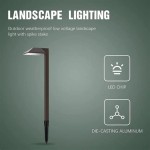Best Outdoor Path Lighting Solar Systems: A Comprehensive Guide
Outdoor path lighting serves a dual purpose: enhancing the aesthetic appeal of a property and providing a safe and navigable passage after dark. Solar-powered path lighting systems offer an energy-efficient and environmentally conscious alternative to traditional wired lighting. This article aims to provide a comprehensive overview of the best outdoor path lighting solar systems available, outlining key features, benefits, and considerations for selecting the optimal system for specific needs.
The market for solar path lighting has expanded significantly in recent years, presenting consumers with a wide array of options. These range from simple, low-cost models to more sophisticated systems with advanced features like motion detection, adjustable brightness, and varying light colors. A careful evaluation of individual needs and priorities is essential for making an informed purchase.
Understanding the Components of Solar Path Lighting Systems
Solar path lights typically consist of several key components that work together to convert sunlight into usable light. These components include a solar panel, a rechargeable battery, a light source (usually LEDs), a controller, and an enclosure.
The solar panel is responsible for capturing sunlight and converting it into direct current (DC) electricity through the photovoltaic effect. The efficiency of the solar panel, measured as the percentage of sunlight converted into electricity, significantly impacts the performance of the lighting system. Higher efficiency panels can generate more power in shorter timeframes, leading to longer illumination periods, particularly during periods of low sunlight.
The rechargeable battery stores the electricity generated by the solar panel during the day, providing power to the light source at night. The battery type and capacity determine the length of time the light can operate without sunlight. Nickel-metal hydride (NiMH) and lithium-ion batteries are commonly used in solar path lights. Lithium-ion batteries generally offer longer lifespans and higher energy densities compared to NiMH batteries, but may also be more expensive.
The light source in most modern solar path lights is a light-emitting diode (LED). LEDs are energy-efficient, long-lasting, and available in a variety of colors and brightness levels. The lumen output of the LED determines the brightness of the light. Choosing the appropriate lumen output is crucial for ensuring adequate illumination of the pathway without causing excessive glare.
The controller manages the charging and discharging of the battery, regulates the light output, and may incorporate features like automatic on/off switching and dimming. A well-designed controller protects the battery from overcharging and deep discharging, thereby prolonging its lifespan.
The enclosure houses all the components and protects them from the elements. The material used for the enclosure should be durable and weather-resistant. Common materials include stainless steel, aluminum, and various types of plastic.
Factors to Consider When Choosing Solar Path Lighting
Several factors should be carefully considered when selecting solar path lighting systems. These include geographic location, sunlight availability, desired brightness, budget, and aesthetic preferences.
Geographic location significantly impacts the amount of sunlight available throughout the year. Regions with more sunlight inherently offer better performance for solar lighting systems. In areas with limited sunlight, it's crucial to select systems with high-efficiency solar panels and large-capacity batteries.
Sunlight availability at the installation location is another critical factor. Trees, buildings, and other obstructions can cast shadows on the solar panels, reducing their ability to generate electricity. Ensure the solar panels are positioned to receive direct sunlight for several hours each day. Consider trimming or relocating obstructions if necessary to optimize sunlight exposure.
The desired brightness of the path lighting should be determined based on the specific application. Brighter lights are generally preferred for areas with heavy foot traffic or potential hazards. However, excessive brightness can cause glare and light pollution. A balance should be struck between safety and aesthetics.
Budget is always a primary consideration. Solar path lights are available at a wide range of price points. While cheaper models may be tempting, they often compromise on quality and performance. Investing in a higher-quality system may result in greater long-term value due to improved durability and longer lifespan.
Aesthetic preferences also play a significant role in the selection process. Solar path lights are available in a variety of styles, finishes, and colors. Choose lights that complement the existing landscape design and architectural style of the property. Consider the size and shape of the lights, as well as the color temperature of the LEDs.
Evaluating Key Features of Top-Rated Solar Path Lights
To identify the best outdoor path lighting solar systems, several key features should be evaluated. These features include solar panel efficiency, battery capacity, LED brightness and color temperature, weather resistance, ease of installation, and warranty.
Solar panel efficiency, as previously mentioned, is a critical determinant of performance. Look for systems with solar panels that have a high efficiency rating, typically 17% or higher. Monocrystalline solar panels generally offer higher efficiency compared to polycrystalline panels.
Battery capacity determines the duration of illumination after a full charge. Higher capacity batteries provide longer runtimes, especially during cloudy days or winter months when sunlight is limited. A battery capacity of at least 600mAh is recommended for most applications.
LED brightness, measured in lumens, indicates the amount of light emitted. The appropriate lumen output depends on the specific application. For general path lighting, a lumen output of 20-50 lumens per light is often sufficient. The color temperature of the LED, measured in Kelvin, affects the appearance of the light. Warmer color temperatures (2700K-3000K) create a cozy and inviting atmosphere, while cooler color temperatures (4000K-5000K) provide brighter and more focused illumination. Many systems now offer adjustable color temperatures.
Weather resistance is crucial for ensuring the longevity of the solar path lights. Look for models with an IP rating of at least IP44, which indicates protection against splashing water. Higher IP ratings, such as IP65 or IP67, offer greater protection against dust and water ingress.
Ease of installation is another important consideration. Solar path lights are typically easy to install, requiring no wiring or electrical expertise. Most models can be simply staked into the ground. Choose lights with a sturdy and user-friendly installation mechanism.
A warranty provides assurance of the quality and reliability of the product. Look for systems with a warranty of at least one year. A longer warranty indicates greater confidence on the part of the manufacturer.
Beyond these core features, some solar path lighting systems offer additional functionalities that enhance their value. Motion detection, for example, allows the lights to automatically brighten when motion is detected, providing added security and energy savings. Adjustable brightness settings enable users to customize the light output based on their preferences and needs. Some systems even offer smart features, such as remote control via a smartphone app.
Careful consideration of these key features will enable consumers to choose the best outdoor path lighting solar system for their specific needs and circumstances. Prioritizing quality, durability, and performance will result in a long-lasting and effective lighting solution.
In conclusion, selecting the best outdoor path lighting solar system requires a thorough understanding of the components, factors to consider, and key features. A comprehensive evaluation of individual needs and priorities, coupled with a careful comparison of available options, is essential for making an informed decision. By prioritizing quality, durability, and performance, consumers can enjoy the benefits of energy-efficient and aesthetically pleasing path lighting for years to come.

The Best Solar Path Lights Of 2024 According To Testing Bob Vila

5 Best Outdoor Solar Lights Of 2024 Reviewed

5 Best Outdoor Solar Lights Of 2024 Reviewed

The Best Solar Landscape Lights Of 2024 Popular Science

5 Best Outdoor Solar Lights Of 2024 Reviewed

The 3 Best Smart Outdoor Lights For Backyards Of 2024 Reviews By Wirecutter

Best Solar Lights On Test In 2024 Bbc Gardeners World

Best Solar Path Lights Power For Walkway Pathway

The Best Solar Landscape Lights Of 2024 Popular Science

Best Outdoor Solar Lights 2024 Forbes Vetted







